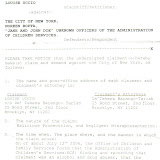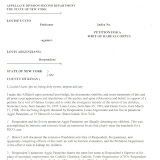I came accross this fantastic post on Parent Alienation and had to share..
by Despina Vassiliou
Department of Educational Psychology and Counselling,
McGill University 3700 McTavish, Montreal, QC, Canada H3A 1Y2
A thesis submitted in partial fulfilment of the requirements for the degree of Master of Arts in Educational Psychology
ABSTRACT
This qualitative study examines alienated parents’ perceptions of their own experience of Parental Alienation Syndrome (PAS). The participants were five fathers and one mother. The data were collected via semi-structured, open-ended interview questionnaires.
A qualitative analysis of the data was performed for each participant in an attempt to answer the following questions:
(1) Are there characteristics (e.g., number of children, number of marriages, etc.) common to alienated families?
(2) Are there common themes or issues among the conflicts between couples that contribute to marriage dissolution?
(3) From the lost parent’s perspective, are there commonalities in the underlying causes of the alienation?
(4) Are there common themes in the participants’ experience of the alienation process?
(5) Given the opportunity what are some things that the lost parents perceive they might do differently? The findings are discussed and the limitations of the present study are given.
CHAPTER 1
THE NATURE OF PARENTAL ALIENATION SYNDROME
Dr. Richard A. Gardner, a forensic and child psychiatrist, has conducted evaluations regarding the custody of children following divorce (Rand, 1997). Through his case work he observed that many divorcing families shared common characteristics which he labeled as Parental Alienation Syndrome (PAS). PAS was defined as a syndrome where one parent (usually the custodial parent) alienates the child or children from the other parent. PAS includes the alienating parent engaging the child in a series of conscious and subconscious techniques like brainwashing in an attempt to denigrate the other parent. Further, the child also contributes to the denigration of the allegedly hated parent (Cartwright, 1993; Gardner, 1992). The general pattern of characteristics PAS children display during and after the divorce have been described by Gardner (1992) as follows:
1. Campaign of denigration: PAS children denigrate the “lost” parent completely, particularly in the presence of the alienating parent. The children express a profuse hatred for the lost parent. Initially, the children may denigrate each parent in the presence of the other. Eventually they learn that the denigration of the non-custodial or alienated parent is beneficial within the custodial home (Cartwright, 1993; Gardner, 1992). Subsequently, the child rejects the lost parent completely.
2. The children’s unfounded rationalizations: The children base their denigration on rationalizations that are weak or frivolous, e.g. “she snores in her sleep”. Statements such as these are often made with a complete lack of ambivalence by the children. The alienating parent, as well, does not question such statements as the bases for denigration and further uses the children’s statements as evidence of the lost parent’s inadequacy (Cartwright, 1993; Gardner, 1992).
3. Dichotomization of the parents: The alienating parent is perceived by the child as encompassing only positive qualities and as such the children attempt to express themselves as “perfect little photocopies” (Goldwater, 1991 p. 126) of the alienating parent. On the other hand, the lost parent is believed to encompass only negative qualities. This negative attitude is generalized to events that the children and lost parent have shared. Even events that the children once enjoyed are now remembered as being forced, not enjoyed, or never even remembered (Cartwright, 1993; Gardner, 1992).
4. The independent thinker phenomenon: The children present the decision to reject the parent as their own. The alienating parent reinforces this contention by making such statements as “I can’t force her to see her dad, if she does not want to”. Further, the claim that the decision to reject the parent was the child’s own is made suspect by the child’s use of language and phrases that are developmentally inappropriate and indicative of the alienating parent’s influence (Cartwright, 1993; Gardner, 1992).
5. Automatic love of the alienating parent: the children automatically and reflexively support the alienating parent. This automatic love may be a consequence of the belief that the alienating parent is an ideal or perfect person or that the children perceive that parent as weak and in need of support and defending (Cartwright, 1993; Gardner, 1992).
6. Absence of guilt: The children do not express any feelings of guilt about the circumstances surrounding the relationship with the lost parent. There is a lack of gratitude for any gifts, favours, etc.. This lack of guilt cannot be attributed solely to cognitive immaturity but is related to the brainwashing done by the alienating parent (Cartwright, 1993; Gardner, 1992).
7. Borrowed scenarios: The children use language and expressions that are clearly not their own. The quality with which they express their beliefs appears to be coached and rehearsed, and the only source of the borrowed scenarios appears to be the alienating parent (Cartwright, 1993; Gardner, 1992). For instance, a five year old borrows the alienating mother’s words and say “Daddy’s new girlfriend is a whore!” (Cartwright, 1993, p. 207).
8. Generalization of animosity: The lost parent’s extended family is also included in the animosity. These individuals are also perceived as encompassing negative qualities or inappropriate actions since they are associated with the lost parent. For instance, any attempt by the extended family to counter the denigration of the lost parent is viewed by the children as an attack on their beliefs that they must defend (Cartwright, 1993; Gardner, 1992).
Further, Cartwright, 1993 postulated that often allegations of abuse associated with PAS may be virtual. Virtual allegations refer to cases where the abuse is simply suggested in order to cast aspersions the lost parent’s character without the alienating parent having to fabricate real incidents of alleged abuse. For example, in one case, the mother hinted at an allegation of sexual abuse by accusing the father of renting a videotape containing pornography for the child. The mother reported in court that the child was disappointed with the movie because it was “suggestive, erotic, and pornographic”. The movie, a Hollywood comedy starring Chevy Chase, was chosen by the child at a family video store. The judge proceeded to interview the child extensively and, disagreeing with the mother, found that the child was not disappointed in the movie because it was pornographic but rather because it was not funny. Virtual allegations are subtle and, as a result, difficult to prove or disprove. Therefore, Cartwright, 1993 postulates that as lawyers and judges become more aware of PAS and become more skilled at detecting it, the incidence of virtual allegations will increase.
As in most disorders, the severity of PAS can range from mild to severe. As a result, Gardner (1991, conference) has described three levels in the continuum of severity of the syndrome as mild, moderate, and severe. Using these anchor points, Gardner (1992) described the characteristics of the alienating parent and the child.
In a Severe level of PAS, the alienating parent demonstrates paranoid thoughts that may be limited to the lost parent or may generalize to other circumstances. Prior to the divorce, however, the alienating parent may not have demonstrated any paranoia. Another characteristic includes the alienating parent’s obsession with preventing the lost parent from having or exercising any visitation rights. The alienating parent will use any means necessary to ensure this goal. Further, alienating parents project their own negative qualities onto the lost parents, reinforcing their own paranoia and portraying themselves as victims. As a result of this paranoia, alienating parents do not respond with appeals to logic or reason, or even to confrontations with reality. Those who do not support the alienating parents’ beliefs, whether they are mental health professionals, lawyers, etc., are believed either to be against them or to be paid by the lost parent. The children in severe cases of PAS share the alienating parent’s paranoia about the lost parent. They will refuse to visit the lost parent and often demonstrate panic and hostility that renders visits impossible. Further, if visitation does occur, once they are in the lost parent’s home they may run away, become paralyzed with fear, or become destructive to the extent that they must be removed from the home.
The Moderate level of PAS includes alienating parents who exhibit more rage than paranoid tendencies. They are able to make some distinction between a child’s preposterous allegations and those which may have some validity. However, as in severe cases, an alienating parent in a moderate case of PAS will also undertake a campaign of denigration against the lost parent and will tend to prevent the lost parent’s exercise of visitation rights. Prior to the divorce, the moderate alienating parent is more likely to have been a good child rearer. The children of moderate PAS tend to be less persistent with their campaigns of denigration, and are more likely to abandon them in the presence of the lost parents, especially after long periods of time. In this type of case campaigns of denigration by younger children in the presence of their lost parents can only be sustained with the help of older siblings who function as surrogate parents during visitation. The alienated children’s primary motives for maintaining campaigns of denigration are to maintain “healthy” psychological bonds with the alienating parents.
The Mild level of PAS, the parents have generally healthy psychological bonds with their children. They respond to logic and reason in that they recognize that the alienation of the non-custodial parent is not beneficial for the children. Therefore, the alienating parent will be willing to take a conciliatory approach towards the lost parent’s requests. Gardner (1992) also notes that mild cases of PAS require considerablyless therapy than the more severe cases. Further, the children may become healthier when the intervention simply requires the child to remain in the presence of the lost parent over time.
Cartwright (1993) noted that the time that is spent alienating the child may be an indicator of the degree to which the child is alienated; the longer the alienation, the more alienated the child. Further, the excessive alienation may “build up” or increase the risk of mental illness in the child. As a result, the sooner the children are removed from the alienating situation, the healthier it is for the lost parent and the PAS children. It is, therefore, important to gain a better understanding of parental alienation, its development, and its termination, because of the devastating consequences of PAS to the family members who experience it.
Operational Definitions
Alienator or Alienating Parent. The terms “alienator” and “alienating parent” are used to designate the parent who influences the child or children to turn against the other parent.
Lost or Hated or Absent Parent. The lost (and usually non-custodial) parent is the one who is the target of the alienator.
Conflict. This term signifies opposing ideas and beliefs that members of the family experience in the form of arguments that may or may not become violent.
Alienation: This term signifies any actions, whether physical or psychological, that lead to the negative perception of a parent. Specifically, the term alienation refers to tactics utilized in order to induce PAS.
http://www.fact.on.ca/Info/pas/vassil98.htm
Copyright Notice: According to US Copyright law, copyright vests initially in the author(s) of the work. In accordance with Title 17 U.S.C. section 107, any copyrighted material herein is distributed without profit or payment to those who have an interest in receiving this information for non-profit research and educational purposes only. For more information go to: Title 17, Sec.107. If you are the copyright holder and choose to have your work removed from this website, email HaveUmistakenMe@aol.com and it will be done. However, we hope you prefer that our researchers continue to benefit from access to your work.
Sunday, May 17, 2009
Subscribe to:
Post Comments (Atom)























No comments:
Post a Comment